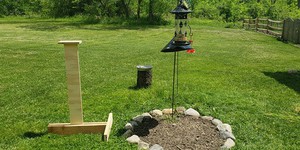Others Like “Sound Localization” (top 20 results)
|
Eardrums are membranes inside your ears that vibrate when sound waves hit them. These vibrations are converted into electrical signals and sent to your brain, which allows you to hear sound. The frequency response of your eardrum, or the range of frequencies that will cause it to vibrate, determines your hearing range. Typical human hearing ranges from about 20 Hz up to 20,000 Hz, although the ability to hear high frequencies typically degrades as you get older. Some other animals can…
Read more
Try different wind turbine/propeller (chord length, pitch) designs by making models from balsa wood. Connect the spinning axle to a DC motor and measure the voltage produced across a resistor to measure power output. Use fan as wind source. (Judge, 2004)
Read more
What causes landslides? The USGS Landslide Hazards Program conducts research needed to answer major questions related to landslide hazards. Where and when will landslides occur? How big will the landslides be? How fast and how far will they move? What areas will the landslides affect or damage? How frequently do landslides occur in a given locality? Investigate the patterns of landslide occurrence in your area. Are they related to locations, geology, or topography? Are they more frequent…
Read more
Did you know that you can make a simple hygrometer (a device for measuring the relative humidity of the air) with hair? Search online for instructions to build one. Does the type of hair used in the hygrometer affect the accuracy of the results? Do some types of hair respond faster than others? Do some types of hair give a larger (or smaller) response? You could get hair samples from classmates, or a local beauty shop. Use hair samples of equal length to construct each hygrometer. To force…
Read more
Aerodynamics and Hockey: Does the Force of Drag Have an Effect on the Distance the Puck Will Travel?
Think of a way to launch the puck with a reproducible force, and examine the effect of launching the puck in different orientations on the distance it travels. For more information on the physics, see Haché, 2002.
Read more
This project idea is inspired by former NASA engineer Mark Rober's "Squirrel Ninja Obstacle Course":
You do not need to build a full obstacle course as intricate as Mark's (although you certainly can if you want to!) to make this into a fun science project. For example, how far can squirrels jump? You could test this question by building a mobile post and placing it next to a bird feeder. The bird feeder in Figure 1 is mounted on a metal pole. The pole is protected by a squirrel baffle, a…
Read more
You can look up information about local air pollution, such as the Air Quality Index (AQI), online or even get alerts on your phone. But what if you could wear a device that continuously monitors the air quality around you in real time, alerting you to unsafe levels? Such a device could alert a person with asthma when they need to go inside, let you know if smoke from a nearby wildfire is drifting in your direction, or signal when it is time to take a break on a hazy summer day. The Science…
Read more
Measurements are very important for scientists. It is especially important that the measurements be accurate. Think about how important accuracy is when you want to know if you are taller than a friend of yours, every inch counts! In this experiment, you will investigate how different objects can be measured with accuracy. Are small or large objects more difficult to measure? Who in your family is the best at measuring? Maybe it will be you!
Read more
What do a guitar, a piano, a harp and a violin have in common? Turns out a couple of things, including a soundboard. All stringed instruments use a soundboard to amplify (greatly increase) the volume of the sound coming from vibrations of the strings. The soundboard is positioned so that it gathers the sound vibrations coming from the strings and then retransmits them at an even greater volume when it begins to vibrate. Soundboards are common in the world of musical instruments, but they can…
Read more
Let's suppose you can take advantage of the Internet and get a 'pen pal' located a 1000 miles away in another city. On the same night, and at EXACTLY the same time 'Universal Time', make a CAREFUL observation of where the Moon is located with respect to the background stars. You should be able to discern a slight (about 1/2 the Moon's diameter) shift in position due to parallax. Then, with a little geometry, you could estimate the distance of the Moon during the full lunar cycle (Odenwald,…
Read more
|
Explore Our Science Videos
Test Your Foods for Starch
Candy Snap! Does freezing candy make it more brittle?
How Antibiotic Resistant Bacteria Take Over – STEM activity









